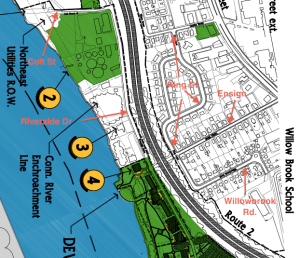Archive for the ‘land-use’ Tag
A Meeting by Happenstance
Last week, I ran into the Vice President of Goodwin College and we began discussing the progress of the land-use history I am working on for his organization. The meeting began with me asking if Goodwin College owned a piece of property in Wethersfield on the West bank of the Connecticut River known as Crow’s Point. I asked him this because there was an abundance of primary source documents in “the pile” of resources I have been combing through (This “pile” is his research on this project to date). He remarked that the college has owned the property since 2006 and that he would like this included in the land-use history. My first reaction was, “nice.” This property had some documentation about how the land was used, preserved and planned to be developed. I thought this would fit nicely into the Environmental History angle that I was working on. I figured that this would be a good time to bounce this angle off of him to see what came back. His response was a bit troublesome.
 Although he did seem interested in the idea of how the land was used, abused, and renewed, the Vice President wanted the research to focus on the “interesting things” that have happened on the property. Then, I tried to explain that I would definitely include such information, but I was looking for an angle that would contribute to the field of history. I remarked, “I am looking for an angle that will appeal to a wider audience, something that may get published.” He responded that they will publish it and not to worry about it. By the way we were interacting, I could tell that I was talking to a history buff, not a historian. Then, I asked some clarifying questions that gave a refocus to my research. After this 4-5 minute meeting, I came to understand that they really wanted a chronology of the development of the land. They wanted some of the history of Pratt and Whitney and the development of the neighborhood pictured here that is adjacent to the Goodwin College Riverfront Campus. They want to know more about the ferry that Colt created to help his workers circumvent the tolls in and out of Hartford. They are seemingly less interested in the rejuvenation of the land that their riverfront campus occupies, although the do want some of this included. Overall, I am grateful for this meeting and the amount of research that the Vice President has put into this project.
Although he did seem interested in the idea of how the land was used, abused, and renewed, the Vice President wanted the research to focus on the “interesting things” that have happened on the property. Then, I tried to explain that I would definitely include such information, but I was looking for an angle that would contribute to the field of history. I remarked, “I am looking for an angle that will appeal to a wider audience, something that may get published.” He responded that they will publish it and not to worry about it. By the way we were interacting, I could tell that I was talking to a history buff, not a historian. Then, I asked some clarifying questions that gave a refocus to my research. After this 4-5 minute meeting, I came to understand that they really wanted a chronology of the development of the land. They wanted some of the history of Pratt and Whitney and the development of the neighborhood pictured here that is adjacent to the Goodwin College Riverfront Campus. They want to know more about the ferry that Colt created to help his workers circumvent the tolls in and out of Hartford. They are seemingly less interested in the rejuvenation of the land that their riverfront campus occupies, although the do want some of this included. Overall, I am grateful for this meeting and the amount of research that the Vice President has put into this project.
This happenstance meeting helps me in several ways. First, it helps to cut out some of the unnecessary research I was conducting about the floodplains near the Putnam Bridge. Next, it helps me refocus my attention to the development of the community just East of the campus. Finally, it helps me focus less on the remediation of the property, thus cutting out the last 5-8 years. This process is interesting because, if this were solely my own project, it would focus on the use, abuse, and renewal of the property, examining how and why this use has changed over time, and linking this change to broader themes within environmental history. I wouldn’t say that this project is any less valuable, just different. As a public historian, I guess it is not my place to place value on a project or its outcomes. The value of the project is set by the contracting party and I am not at liberty to share the “value” of this project.
 Comments (1)
Comments (1)